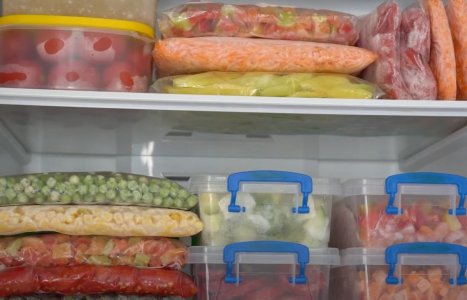How to keep your Christmas leftovers safe and delicious
By
Veronica E.
- Replies 0
The holidays are a time for laughter, family, and food that seems to last for days.
Once the wrapping paper settles and the last guest leaves, many of us find ourselves staring at an overstuffed fridge filled with turkey, ham, stuffing, and all the trimmings.
Those leftovers are one of the best parts of the season—until they’re not.
What starts as a tasty second helping can quickly turn into a health risk if food isn’t stored or reheated properly.
Before you dive back into that cold turkey sandwich or casserole, it’s worth taking a moment to make sure your leftovers are safe to enjoy.

How long do Christmas leftovers really last?
According to FoodSafety.gov, most holiday leftovers stay safe in the refrigerator for three to four days.
That means if you cooked on Christmas Day, you should plan to finish the leftovers by Sunday unless you freeze them sooner.
Beyond that point, spoilage bacteria begin to multiply, and even if food looks or smells fine, it might not be safe to eat.
Some harmful bacteria don’t produce any odor at all, so it’s best not to take chances.
Here’s a simple guide to keep in mind:
Also read: Think it’s safe? This leftover might be more dangerous than you realize
Freezing leftovers for later
If you’re not quite ready to part with your Christmas feast, the freezer can help stretch your holiday joy.
Most cooked meats, casseroles, and baked goods freeze well. To keep your food tasting its best:
It’s like giving your Christmas dinner a second life—and saving yourself from cooking on a busy weeknight later on.
Also read: What really happens to Walmart’s leftover cake scraps, according to an employee
Reheating the right way
Reheating isn’t just about bringing back flavor—it’s about safety, too.
Bacteria can survive if food isn’t heated thoroughly, so make sure your leftovers reach the right temperature.
Also read: Creative ways to turn holiday leftovers into new meals
Why food safety matters more as we age
While the United States has one of the safest food systems in the world, foodborne illnesses still affect millions every year.
The FDA estimates that one in six Americans gets sick from contaminated food annually, leading to over 100,000 hospitalizations.
Older adults, young children, and people with weaker immune systems face higher risks of severe symptoms or complications.
Common signs of food poisoning include nausea, vomiting, diarrhea, fever, and stomach cramps.
If you or someone you know develops high fever, dehydration, or confusion after eating, it’s best to seek medical care immediately.
Also read: The surprising history of leftovers in American kitchens
Smart leftover safety habits
You don’t need to overthink it—just follow a few simple steps to keep your fridge (and your stomach) in good shape:
Also read: The right way to reheat chicken and keep your leftovers safe
Need help or advice?
If you’re unsure about whether something is safe to eat, the USDA Meat and Poultry Hotline is there to help.
You can call 1-888-MPHotline (1-888-674-6854), email [email protected], or chat live at ask.usda.gov from 10 a.m. to 6 p.m. Eastern Time, Monday through Friday.
With just a few simple precautions, your holiday meals can stay both delicious and safe.
Enjoy the season’s leftovers with confidence—and maybe a little extra cranberry sauce on the side!
Read next:

What’s your favorite way to reinvent Christmas leftovers? Do you have a go-to recipe for turkey soup or creative ideas for leftover ham? Or maybe you’ve had a food safety lesson the hard way? Share your thoughts, tips, and stories in the comments—let’s help everyone enjoy a healthy, happy holiday season.
Once the wrapping paper settles and the last guest leaves, many of us find ourselves staring at an overstuffed fridge filled with turkey, ham, stuffing, and all the trimmings.
Those leftovers are one of the best parts of the season—until they’re not.
What starts as a tasty second helping can quickly turn into a health risk if food isn’t stored or reheated properly.
Before you dive back into that cold turkey sandwich or casserole, it’s worth taking a moment to make sure your leftovers are safe to enjoy.

Proper storage and reheating can turn Christmas leftovers into safe, satisfying meals well beyond the holiday. Image Source: YouTube / Institute of Food Technologists - IFT.
How long do Christmas leftovers really last?
According to FoodSafety.gov, most holiday leftovers stay safe in the refrigerator for three to four days.
That means if you cooked on Christmas Day, you should plan to finish the leftovers by Sunday unless you freeze them sooner.
Beyond that point, spoilage bacteria begin to multiply, and even if food looks or smells fine, it might not be safe to eat.
Some harmful bacteria don’t produce any odor at all, so it’s best not to take chances.
Here’s a simple guide to keep in mind:
- Refrigerator: 3–4 days for most cooked foods
- Freezer: Best quality within 2–6 months (food remains safe longer, though texture and flavor may change)
Also read: Think it’s safe? This leftover might be more dangerous than you realize
Freezing leftovers for later
If you’re not quite ready to part with your Christmas feast, the freezer can help stretch your holiday joy.
Most cooked meats, casseroles, and baked goods freeze well. To keep your food tasting its best:
- Store items in airtight containers or heavy-duty freezer bags to prevent freezer burn.
- Label everything clearly with the date and contents—future you will appreciate the reminder.
- For best flavor and texture, aim to use frozen foods within two to six months.
It’s like giving your Christmas dinner a second life—and saving yourself from cooking on a busy weeknight later on.
Also read: What really happens to Walmart’s leftover cake scraps, according to an employee
Reheating the right way
Reheating isn’t just about bringing back flavor—it’s about safety, too.
Bacteria can survive if food isn’t heated thoroughly, so make sure your leftovers reach the right temperature.
- Temperature check: Heat all leftovers to at least 165°F (75°C). Use a food thermometer for accuracy.
- Soups and gravies: Bring to a rolling boil before serving.
- Microwaving: Cover and rotate food to heat it evenly. Add a splash of water if it looks dry, and let it rest for a minute before checking the temperature.
- Thick vs. thin foods: Large roasts or casseroles will take longer to heat than lighter dishes like mashed potatoes.
- Frozen meals: You can reheat them directly from the freezer—just allow more time and check that they’re hot all the way through.
Also read: Creative ways to turn holiday leftovers into new meals
Why food safety matters more as we age
While the United States has one of the safest food systems in the world, foodborne illnesses still affect millions every year.
The FDA estimates that one in six Americans gets sick from contaminated food annually, leading to over 100,000 hospitalizations.
Older adults, young children, and people with weaker immune systems face higher risks of severe symptoms or complications.
Common signs of food poisoning include nausea, vomiting, diarrhea, fever, and stomach cramps.
If you or someone you know develops high fever, dehydration, or confusion after eating, it’s best to seek medical care immediately.
Also read: The surprising history of leftovers in American kitchens
Smart leftover safety habits
You don’t need to overthink it—just follow a few simple steps to keep your fridge (and your stomach) in good shape:
- Cool quickly: Refrigerate leftovers within two hours of serving. Don’t leave food sitting out after dinner.
- Store smartly: Divide food into shallow containers so it cools faster.
- Trust your instincts: If you can’t remember when something went into the fridge, throw it out.
- Keep clean: Wash your hands, utensils, and kitchen surfaces before and after handling leftovers.
Also read: The right way to reheat chicken and keep your leftovers safe
Need help or advice?
If you’re unsure about whether something is safe to eat, the USDA Meat and Poultry Hotline is there to help.
You can call 1-888-MPHotline (1-888-674-6854), email [email protected], or chat live at ask.usda.gov from 10 a.m. to 6 p.m. Eastern Time, Monday through Friday.
With just a few simple precautions, your holiday meals can stay both delicious and safe.
Enjoy the season’s leftovers with confidence—and maybe a little extra cranberry sauce on the side!
Read next:
- Think twice before microwaving these 15 common foods
- Don't risk it: The key day to toss your Thanksgiving leftovers
- Stop microwaving these 5 foods immediately–expert warnings you can’t ignore
Key Takeaways
- Christmas leftovers can be safely enjoyed for three to four days in the fridge, or longer if frozen within that time frame.
- Frozen leftovers taste best within two to six months, though they remain safe beyond that if properly sealed.
- Reheat all cooked foods to at least 165°F to eliminate harmful bacteria and ensure safe consumption.
- Older adults are more susceptible to foodborne illness, so proper storage, reheating, and hygiene are essential for safety.
What’s your favorite way to reinvent Christmas leftovers? Do you have a go-to recipe for turkey soup or creative ideas for leftover ham? Or maybe you’ve had a food safety lesson the hard way? Share your thoughts, tips, and stories in the comments—let’s help everyone enjoy a healthy, happy holiday season.






